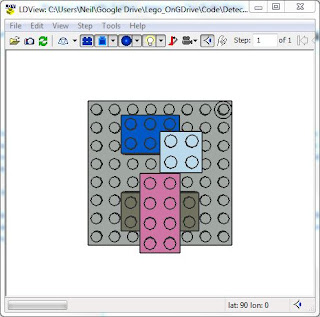Managing the addition of both rotated bricks and "odd" bricks like 1x2 and 2x3 required me to rework the "Build Matrix" that I use to track the placement of bricks as they added to the ldr file.
You can see the build matrix in the image above on the left (along with the ldr file and the ldview image. This tracks each brick as it's added to the .ldr file and calculates the studs and dimensions of the bricks. This allows the code to track the placement of each brick as it's added to both the .ldr file and the build matrix.
I also re-orientated the build matrix so that it matched the top view - this is where the single red stud buried in the top right hand corner of the model became important as it provided a reference point on model that I could match to the matrix - and the stud is buried in the plate so as not to effect the actual build matrix itself.
The problem I had was in the mechanism I used to calculate the addition of the new part to the build matrix - once I had reworked that calculation, the build now matrix accurately reflects the placement of bricks in the ldr file. However, if you look carefully at the build matrix you can spot that the build matrix only works by moving the bricks up in height (look at the matrix values for the bottom two "floating" pink studs) - there is currently no option to "back-fill" into holes. This should be possible by combining the build matrix and the data stored in the ldr file so that you could also map the "holes" between bricks that might exist in a model.
With the build matrix now accurately reflecting the addition of parts which had been rotated, or were "odd" bricks (or both!) I could now consider building much taller towers hopefully without any placement errors.




No comments:
Post a Comment